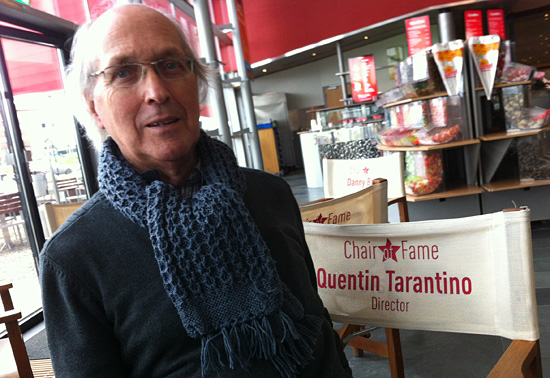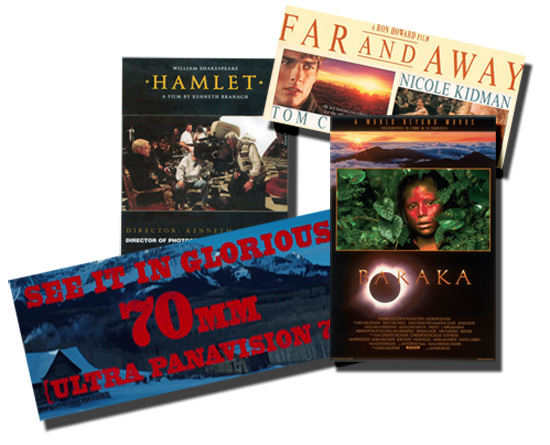Is there still a Future for 65mm Filming and Original 70mm prints? |
Read more at in70mm.com The 70mm Newsletter |
| Written by: Johan C.M. Wolthuis, International 70mm Publishers, Arnhem, The Netherlands. | Date: 13.11.2015 |
 Mr.
Johan Wolthuis, the Dutch 1-man army of 70mm advocacy. Johan started the
International 70mm Association Newsletter in 1988. Mr.
Johan Wolthuis, the Dutch 1-man army of 70mm advocacy. Johan started the
International 70mm Association Newsletter in 1988.In 2012 Keanu Reeves directed a documentary “SIDE BY SIDE” (subtitled: Can Film Survive Our Digital Future) in which he had nearly 70 interviews with film directors, cinematographers, writers, engineers, artists and producers, about their thoughts about digital filming. Among them were James Cameron, Anne V. Coates, David Fincher, Robert Rodriquez, David Lynch, Steven Soderbergh, Christopher Nolan, Vittorio Storaro, Vilmos Zsigmond and many others. Questions about their experiences and feelings about working with film and digital — where are we now and what the future may bring. Martin Scorsese who was also interviewed by Keanu said, that he thinks that celluloid film will always be there! According to the “Side by Side” website: “The documentary investigates the history, process and workflow of both digital and photochemical film creation. We show what artists and filmmakers have been able to accomplish with both film and digital and how their needs and innovations have helped push filmmaking in new directions. It is really a miracle that for almost one hundred years there was only one way to make a movie — with film. Movies were shot, edited and projected using photochemical film. But over the last two decades a digital process has emerged to challenge photochemical filmmaking. “Side by Side” takes an in-depth look at this revolution, what has been gained, what is lost, and what the future might bring.” The most surprising of the “Side by Side” documentary was that different producers mentioned that they still would prefer the “old” way of using film instead of the digital possibilities, especially because the colours of film are different (warmer) from the digital colors. |
More in 70mm reading: Motion pictures photographed in MGM Camera 65 / Ultra Panavision 70 Motion pictures photographed in Super Panavision 70 & Panavision System 65 The Golden Elephant Award 70mm Day in Aalborg Widescreen History Johan Wolthuis The CINERAMA Story Internet link: 70mmpublishers.nl |
A little 70mm history |
|
In May 1992, Variety wrote: “The Future of 65mm productions is fuzzy.” A
whole story about the release of “FAR AND AWAY” (with Nicole Kidman and
Tom Cruise). The first film shot with 65mm cameras since Disney's “TRON”
in 1982. For the release of
"Far and Away", in May 1992, Universal had
1500 35mm prints available for national release in the US and 163 70mm
prints. Producer Brian Grazer and director Ron Howard said that their
movie was a test case for 65mm production. Michael Salomon, their
Director of Photography added: “People do notice the difference: the
definition, the clarity, the color saturation - even if it's on a
subconcious level.” Was the added cost of shooting in 65mm worth it?
Grazer said that the decision to make “Far and Away” in 65mm has raised
the budget by only $ 700.000, an inconsiderable sum for an already
high-cost film. (See
"Digital & 65mm", © 2010 International 70mm
Publishers, The Netherlands).  But the success was not what they had expected and 70mm was still not
back in the front lines. In 1993 Bernardo Bertolucci and his DOP
Vittorio Storaro decided to use Arriflex 65mm cameras for parts of their
“LITTLE BUDDHA” production (with Keanu Reeves as Prince Siddhartha) that
were shot in the Kingdom of Bhutan. The rest of the film was shot in
35mm anamorphic Technovision. A small number of 70mm prints was
available for the release. The film was not a success. In 1996 Kenneth
Branagh showed his love for 70mm by using new Panavision 65mm cameras
for his 4 hour production of
"HAMLET" together with his DOP Alex
Thomson. The process was renamed as
Panavision Super 70 because of the
new lighter cameras. However, it was not a great success, probably one
of the reasons being the 4 hour length, despite many 70mm screenings. In
the meantime producer Mark Magidson had used the
Todd-AO 65mm cameras
for his famous non-verbal production
“BARAKA” in 1993 released with 70mm
prints, in 2010 followed by
"Samsara" filmed with Panavision 65mm
cameras, but only DCP releases (Digital Computer Package). (See
Widescreen History, © 2014 International 70mm Publishers, The
Netherlands). But the success was not what they had expected and 70mm was still not
back in the front lines. In 1993 Bernardo Bertolucci and his DOP
Vittorio Storaro decided to use Arriflex 65mm cameras for parts of their
“LITTLE BUDDHA” production (with Keanu Reeves as Prince Siddhartha) that
were shot in the Kingdom of Bhutan. The rest of the film was shot in
35mm anamorphic Technovision. A small number of 70mm prints was
available for the release. The film was not a success. In 1996 Kenneth
Branagh showed his love for 70mm by using new Panavision 65mm cameras
for his 4 hour production of
"HAMLET" together with his DOP Alex
Thomson. The process was renamed as
Panavision Super 70 because of the
new lighter cameras. However, it was not a great success, probably one
of the reasons being the 4 hour length, despite many 70mm screenings. In
the meantime producer Mark Magidson had used the
Todd-AO 65mm cameras
for his famous non-verbal production
“BARAKA” in 1993 released with 70mm
prints, in 2010 followed by
"Samsara" filmed with Panavision 65mm
cameras, but only DCP releases (Digital Computer Package). (See
Widescreen History, © 2014 International 70mm Publishers, The
Netherlands). Years of silence until 2012 when Paul Thomas Anderson decided to shoot his production of “THE MASTER” with 65mm Panavison cameras. A pity he didn't use the full frame of the 65mm image! Anderson said: “The 1.85:1 aspect ratio sprang from how I saw things in my mind's eye while I was writing”. But the release of some 70mm prints didn't work well, as it didn't have the impact of being 70mm! Another fan of 70mm Christopher Nolan decided to use the Imax 65mm camera for parts of his “INTERSTELLAR” movie in 2013. Cinemas had the choice to screen it with DCP or with 35mm film anamorphic (1:2.35), 70mm 5 perf (1:2.2) or IMAX 70mm (1:1.44)! And in September 2015 Toronto Film Festival had the DCP premiere of Terence Davies “SUNSET SONG”, [exteriors] filmed with Arriflex's ARRI 765 65mm cameras, but not released in 70mm, what a missed chance. But now in 2015 a lot of publicity for Quentin Tarantino's decision to shoot his new production “THE HATEFUL EIGHT” completely with 65mm Panavision cameras. And not the normal Panavision 65, but the Ultra Panavision 70 (anamorphic) process that was used for the last time nearly 50 years ago for “KHARTOUM” (1966). And even although the film will have its premiere around Christmas 2015, a lot is already written about Tarantino's wish to release it the first two weeks only in 70mm, and starting in January, 2016, with the “normal” release, but even then with a choice of 35mm film or DCP! Tarantino initially stated that he wanted to have 100 cinemas get his movie in 70mm. And indeed: recently the Weinstein Company has announced that 96 cinemas in the US and 4 in Canada will have 70mm prints and 70mm equipment on the first day of Christmas! A list will be published soon. The Weinstein Company had been looking for 70mm projectors in silence for nearly a year in close cooperation with Chapin Cutler, president of Boston Light & Sound Company. Some projectors even dated from the fifties, like the famous Philips DP70's, which are often in working condition. Some others had to be refurbished and some pieces had to be manufactured anew. And every 70mm projector also needs a special anamorphic 70mm lens for the Ultra Panavision 70 process! Boston Light & Sound will also be involved in training technical staff and projectionists with the knowledge of running 70mm, as nearly every film projectionist in the world has been laid off and is working in other jobs (or not working, or is now retired). However, in Europe here and there not only in museums (they often have the Ultra Panavision lens in their collection!) but also in large cinemas there are still some 70mm machines waiting, covered with dust, for the things to come! And many are trying to get involved in the Tarantino's 70mm stream. Prices of second hand 70mm projectors have risen to unbelievable heights! Fortunately 65/70mm film services are still alive and well at FotoKem in Burbank, CA, the World's Only Complete 65/70mm Film & Digital Post Facility, they remain a solid resource for filmmakers interested in shooting their films in any format, from 16mm to 65mm, as well as on the latest digital cameras. They share with us the commitment to film origination and exhibition, and a particular love of 65mm capture and 70mm print exhibition. And the Kodak Factory in New York has been saved as the only facility still producing 65 and 70mm film. However it may further be asked if we are going to be seeing some vast renaissance of 70mm exhibition all over the place? It is highly questionable as virtually every film projectionist in the world has been laid off and is working in other jobs (or not working, or is now retired). But Robert Richardson, Director of Photography of “The Hateful Eight” is very optimistic, saying: “And this is just the beginning, as Gareth Edwards' “Rogue One: A Star Wars Story” is reportedly being shot also with Ultra Panavision 70 lenses”! [on video, ed] And every now and then more plans are published to use the 65mm cameras for a new film. Let us hope and emphasize that all cinema directors, their projection supervisors and other staff members will do their utmost to handle the new 70mm prints with the highest possible care to prevent any damage on these new unique 70mm prints with Datasat (DTS) time code. So we will be able to watch these for a long time without any scratches ! Not only in the United States, but also in Europe there is still a lot of interest in 70mm film, regarding the many yearly 70mm Festivals in Bradford in the UK, Karlsruhe in Germany and Krnov in the Czech Republic. There is still a glimmer of hope on the horizon and I do believe and really hope "The Hateful Eight" will be the beginning of a kind of rebirth of 65mm filming with 70mm prints. But like "Far and Away" it could also be another swan song of the beautiful 70mm processes. But let us wait and see what will happen: where there is hope, there is life! Chronological premiere list of major 70mm films |
|
| Go: back - top - back issues - news index Updated 22-01-25 |
